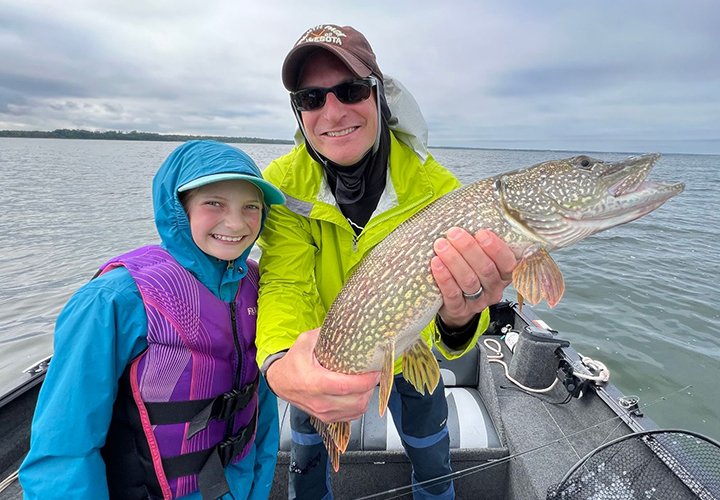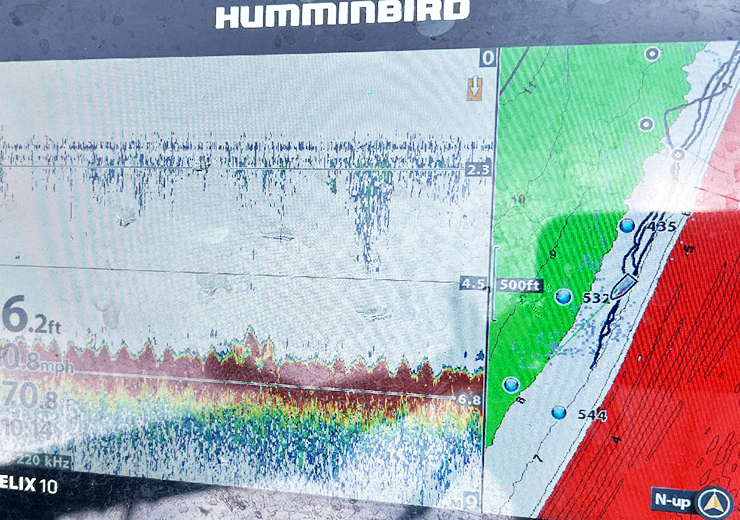It happens every fishing season, the summer peak arrives, water temperatures hit their peak on Lake Winnie and when they do, so does the fishing action. Trolling patterns and fast-moving jigging presentations produce plenty of action, often for more than one species of fish at a time. It’s a fun time, but it doesn’t last forever.
Joyce Damon with hefty Lake Winnie Walleye September 7, 2022
Last week, in fact, for several weeks, prior to the Labor Day Holiday, Lake Winnie was in that summer peak period. Our guests, along with other friends and visitors to the lake enjoyed some of the fastest walleye fishing action that Winnibigoshish has churned out in years. Walleyes from the oft mentioned 2019-year class led the way, but there were plenty of fish from the 2018-year class and even a healthy smattering of larger, 2013-year class fish in the mix too.
Labor Day Weekend arrived and with it, a moderate downturn in surface water temperatures. By Tuesday (9-6) morning, folks on the lake were reporting 66-to-67-degree readings in the morning, which later bounced back to 69 to 70 degrees by late afternoon. The cool down wasn’t all that dramatic, but one notable change, a decline in algae bloom occurred during the cool front and it has affected anglers’ productivity this week.
Joyce Damon family fishing party September 7, 2022 (front to back; Mark, Bri, Kelly & Joyce)
On Wednesday, a particularly warm, calm, and sunny day, fishing action on the big lake was “spotty”. Joyce Damon, one of our annual early fall guests was on the lake fishing with her family and local guide Jeff Sundin when she asked; is it because of the calm water and sunshine that the fish aren’t biting?
“They are still “biting”, Sundin replied. “Whenever we find some and I can see them on the graph, somebody catches one. When you think about it, some spots have been better than others today, but almost every place we’ve stopped has produced something. So, it’s not that they won’t bite, it’s just that fish aren’t stacked up in any single location, so we have to hunt them down. Without weather circumstances that encourage fish to go on the prowl and begin feeding on their own, we just need to cover more ground, check more spots, and work smarter, and harder, for less.”
That story is interesting because it denotes a departure from the trends we’ve experienced during late summer. In recent weeks, calm and sunny days may have “slowed down” fishing action, but even during the most challenging times, walleyes have been active enough to keep most folks happy. So, why does a sunny and calm day make the fishing slower now than it did before?
The difference, we think, can be linked, among other things, to the increasing water clarity. As the water cools and algae blooms die off, shallow water fishing spots will be more heavily dependent on “ideal weather” to produce great action.
The news is not all that bad though, although cooler water temperatures will make fishing tougher over the short term, they will also trigger fall migrations. Soon to begin, Walleyes, perch, and pike too, will begin moving away from summer haunts, across the lake’s mid-depth flats and begin inhabiting steeper structures. Watch for new “schools” of fish to show up on corners and points adjacent to mid-lake bars. The Bena Bar, Horseshoe, Sugar, and Center to name a few, will be good places to look. So will deeper, steeper structures that connect direct to shallow, shoreline flats.
Don’t fall into the trap of believing that the pattern that occurs on one day will automatically work on the day afterward. Your daily routine should include checking some deep water, some mid-depth territory, and some shallow water spots too.
Presentations are beginning to change too. Trolling spinners tipped with minnows, the mainstay presentation for the past several weeks still works. Jig and minnow combinations though, are becoming increasingly popular, especially on breezy days. “Any day we can get a good drift going, I’m fishing with jigs at least part of the time”, Reed Ylitalo says.
Panfish anglers look forward to fall just as much as walleye anglers do. Crappies have been slow to turn up this summer, but some of our guests are finding small schools of them in isolated spots. Cabbage, coontail and other vegetation holds most crappies right now. Begin watching inside corners adjacent to these areas, the ones with steep breaklines that occur close to the shoreline, these are reliable early fall transitional locations.
Crappies move along the edges, and open pockets in the vegetation on short-lived feeding runs during early morning and late evening. Starting your fishing trip early enough to catch the feeding run is a good idea too. Until fish begin showing up in open water territory, casting small jigs tipped with plastic action tails will be your best bet.
Sunfish, which have been active most of this summer continue to be on the prowl. Like crappies, they continue to inhabit the edges of cabbage, coontail and other plants. Key water depths are 6 to 10 feet for either crappies or sunfish.
Perch, when they are caught, have been quality size but low in numbers. Folks can usually gather a half dozen fish in the 10-to-12-inch range, but not often many more than that. Falling temperatures could trigger some changes in perch activity, they usually do, so watch for updates on that front as they become available.
















